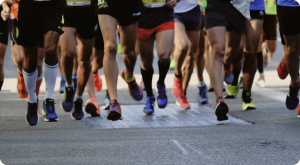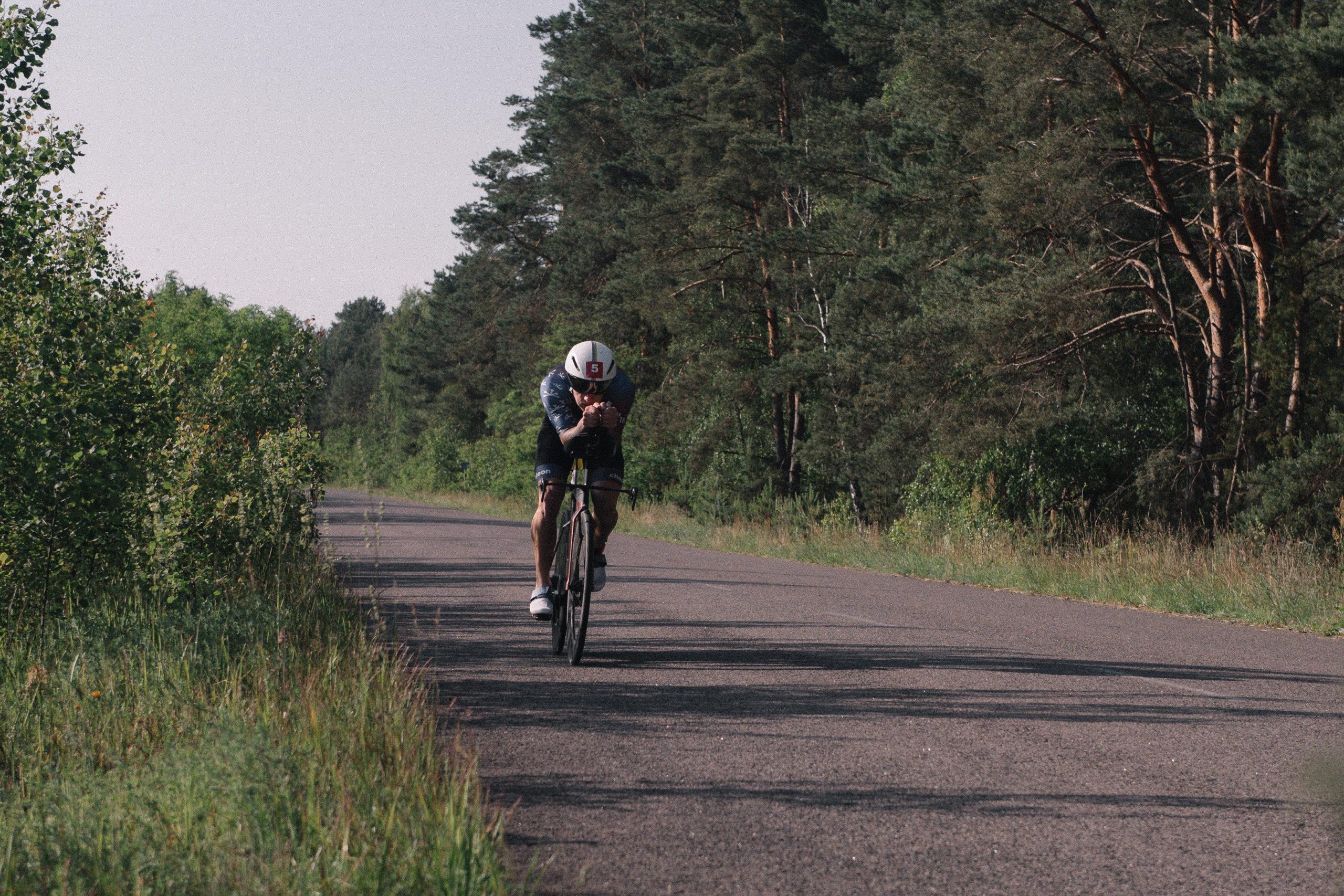The world of triathlon beckons with the promise of a variety of challenges and the thrill of conquering three disciplines in one race.
When newcomers embark on this exciting journey, they are greeted not only with a sense of accomplishment but also with a confusing set of terms that can sound like a foreign language.
From “brick workout” to “transition zone,” this glossary aims to unravel the complex terminology of triathlon.
Imagine being able to communicate with experienced triathletes, understand race instructions with ease, and participate in the sport with a new sense of confidence.
With this glossary you will be able to understand the nuances of the definition of triathlon, opening the door to a world where each term means a new challenge overcome and a step towards mastery.
Let’s embark on this journey of demystification.
It transforms complex terms into accessible knowledge that encourages newcomers to have a rewarding triathlon adventure.
Brick Workout: Transitioning with Precision
In the triathlon lingo, the term “brick workout” is a unique and key concept that offers beginners a glimpse into the dynamic demands of the sport.
This intriguingly named training technique plays a crucial role in preparing athletes to switch between disciplines seamlessly.
In particular, between cycling and running, optimizing their performance.
1. Definition
The term “brick” itself is curious.
It comes from the phrase “brick legs” – the feeling you get in the first moments of running after an intense bike ride.
Imagine feeling as if bricks were tied to your legs as you switch from pedaling to running.
An instant heaviness that serves as a tangible reminder of the body’s adaptation process.
2. A Real-Life Example
Let’s dive into a real-life example: a typical brick workout might include a challenging cycling session followed immediately by a run.
Imagine cycling for a long time, pushing yourself to the limit to simulate race conditions.
When you get off the bike and start running, those “brick legs” kick in.
The initial discomfort is a learning experience, an understanding of the body’s adaptation process.
3. Research
Research confirms the effectiveness of brick training.
Research published in the Journal of Science and Medicine in Sport shows that this training technique significantly improves running performance after cycling.
Athletes who regularly train with bricks demonstrate improved neuromuscular coordination and smoother transitions, which ultimately shaves crucial seconds off their overall race time.
So, brick training is not just a fancy term, it is a strategic training technique designed to prepare triathletes for the unique demands of switching disciplines.
With each workout, newcomers not only build physical strength but also develop the mental toughness needed to overcome the challenges of the triathlon journey.
With the next term in our triathlon terms, we explore the intricacies of drafting, an art that uses physics to conserve energy and optimize speed during the bike leg of a triathlon.

Drafting: The Art of Slipstreaming
In the complex world of triathlon, the term “drafting” refers to a strategic approach that can significantly change the dynamics of a bike stage.
It is often referred to as the art of slipstreaming, where a cyclist rides in the tail of another cyclist.
This is necessary to take advantage of the reduced wind resistance and save energy.
1. Advantages
The aerodynamic advantage of drafting is paramount.
When a cyclist pedals in the air, he creates a trail of disturbed air behind him.
By positioning themselves in this wake, the cyclist behind them enters a zone of reduced wind resistance, spending less energy to maintain a given speed.
The result is significant energy savings that can be crucial for long bike segments of a triathlon.

2. Statistics
Research and statistics emphasize the energy-saving benefits of drawing.
A study conducted by the Center for Sports Medicine and Performance at the University of Colorado Boulder found that using a drift can result in energy savings of up to 30% compared to cycling alone.
In sports where the difference between victory and defeat can be a fraction of a percent, this reduction in energy expenditure can lead to significant time gains, especially over long distances.
3. Disadvantages
However, drafting is not without its challenges.
Maintaining a safe distance and following the drafting rules requires precision and concentration.
This can complicate the already difficult racing conditions.
In addition, the art of slipstreaming requires situational awareness.
Knowing when to pull up behind another cyclist and when to overtake them to avoid penalties.
In conclusion, studies demonstrating quantifiable energy-saving benefits show that this practice has the potential to have a significant impact on race results.
For beginners, understanding the intricacies of folding not only improves their racing strategy but also fosters a respect for balance.
Between individual achievement and adherence to the sport’s rules.
Delving deeper into the concept of the transition zone, we explore the carefully organized area where athletes transition from swimming, cycling, and running with precision and efficiency.

Transition 1 (T1) And Transition 2 (T2): Quick Changes
In triathlon, the transitions from one discipline to another are not just interludes, but crucial moments that can make or break a race.
The triathlon lingo has two terms that capture the essence of these fast and choreographed maneuvers: “T1” and “T2”.
They mean the first and second transitions, respectively.
These transitions represent the art of changing from swimmer to cyclist in T1.
From cyclist to runner in T2.
It’s a delicate ballet of precision and efficiency that can make a big difference in the outcome of a race.
A study published in the Journal of Sports Science & Medicine found that triathletes who manage transitions well tend to outperform their peers.
These valuable seconds saved on transitions contribute not only to the overall race time but also to the psychological support of the momentum needed to win.
Transition 1 (T1): From Swimming to Cycling
Transition 1 marks the journey from the water to the bike.
As athletes emerge from the water, their bodies soaked and adrenaline pumping, the clock continues to tick.
The T1 sequence involves shedding the wetsuit, if worn, and changing into a tri suit or cycling gear.
This process, which seems simple, requires careful organization.
Unzipping, pulling off the wetsuit while the wet skin clings.
After taking off the wetsuit, athletes put on cycling shoes, helmets and any other additional equipment.
The layout of the transition area should be organized in such a way as to ensure smooth movement from the exit of the pool to the bike rack.
Transition 2 (T2): From Bike to Run
Once the bike leg is complete, athletes get off the bike to prepare for the final discipline, running.
Transition 2 is a microcosm of efficiency, where the cycling gear is replaced with running gear.
The transition is marked by a smooth change from cycling shoes to running shoes.
Helmets are replaced by caps, and cycling gloves can give way to sweatbands to control sweating.
This quick change of outfits sets the stage for the run, the final battle of the triathlon.
For beginners, mastering transitions is not just about saving time, it’s a lesson in adaptability, efficiency, and the art of smooth gear changes.
A set of skills that go beyond triathlon and the broader canvas of life itself.
Next, we dive into the world of open-water swimming, which takes place in natural bodies of water such as lakes, rivers, or oceans. Here, we tell you more about the joys and challenges of river swimming.

Open Water Swimming: A Whole New Ballgame
The tranquility of natural bodies of water – lakes, rivers, or oceans – can hide challenges that lurk beneath the surface.
Especially when they serve as a canvas for the swimming leg of a triathlon.
“Open water swimming” marks a departure from the controlled environment of the pool, introducing a whole new set of dynamics.
It presents a unique challenge to athletes.
When triathletes dive into open water, they must navigate not only the distance but also the complexities of currents, waves, and the lack of pool walls. This is especially the case when it comes to river swimming.

Swimming Challenges
1. Navigation
The challenges of open-water swimming begin with navigation.
In a pool, swimmers are guided by a black line on the bottom.
In open water, there is no such landmark.
Navigational markers on the shore or buoys along the course replace the clear lines of the pool.
Swimmers must master the skill of periodically lifting their heads to make sure they are on the right course.
2. Waves and Currents
Waves and currents further complicate open-water swimming.
Unlike pools, where the water surface remains mostly calm, waves appear in open water.
They can cover swimmers.
Currents, often driven by the tides, can change the swimming experience.
They can help or hinder your progress.
3. Lack of Pool Walls
One of the unique challenges that open-water swimmers face is the lack of pool walls.
In a pool, swimmers can push off the walls to gain momentum and conserve energy.
In open water, each stroke requires constant effort, and the walls do not provide a break.
Such prolonged efforts can lead to varying degrees of fatigue and require increased endurance.
The Right Swimming Strategies
When triathletes are aware of these challenges, they can adopt strategies to help them conquer open water with grace.
These include:
1. Practice Aiming
Identifying landmarks on the horizon or using buoys for positioning helps with accurate orientation.
2. Familiarize Yourself with the Conditions
Whenever possible, practice in open water in conditions similar to those of a race.
Simulating waves and currents during training can help swimmers adapt and develop coping strategies.
3. Positioning and Drafting
Strategic positioning in a group of swimmers can offer opportunities for drafting, similar to cycling.
If you find a swimmer to swim behind, you can reduce the resistance of waves and currents.
4. Stay Calm
The vastness of open water can be overwhelming.
Keeping your composure and focusing on the rhythm of your strokes can help swimmers overcome anxiety.
5. Practice Overtaking
Mastering the art of overtaking slower swimmers while maintaining course direction can prevent unnecessary detours.
For newcomers, open water swimming is a testament to the versatility of the sport, where strategic skill complements physical strength, turning each swim into a deliberate journey to triumph.
As we move forward, we delve into the world of “aid stations,” pivotal oases that provide triathletes with essential hydration and nourishment during their grueling journeys.

Aid Stations: Refueling and Hydration
Amidst the intense demands of triathlon, where endurance is tested and limits are pushed, the oasis of aid stations becomes a beacon of nutrition and hydration.
These strategically located points along the course offer triathletes the opportunity to refuel, replenish and rehydrate.
These are vital steps to maximize performance from start to finish.
Aid stations are more than just pit stops, they play a key role in race strategy.
In the world of triathlon meaning, where distances can range from sprint to Ironman, energy reserves and hydration levels are of paramount importance.
Swimming, cycling, and running require specific nutrition and hydration strategies to prevent the dreaded “bocking” or hitting the wall due to exhaustion.
Maintaining proper hydration levels is key to unlocking performance potential.
Dehydration can lead to decreased muscle function, cognitive impairment, and impaired thermoregulation.
Aid stations provide a means to combat this by offering water, sports drinks, and energy gels.
The Right Strategies for Using the Aid Station
The strategy of health centers has a dual purpose – to provide the necessary nutrition and minimize time wastage.
Here are some strategies for how to effectively utilize aid stations without losing momentum:
1. Practice Makes Perfect
Practice grabbing cups while cycling or running without losing your stride.
This seemingly insignificant skill can save you valuable seconds.
2. Plan Your Meals in Advance
Find out what works for you.
Bring along energy gels or snacks that your body is used to to ensure you replenish your energy stores efficiently without stomach discomfort.
3. Hydration Balance
Drink as you are thirsty, avoiding overhydration, which can lead to discomfort.
Adequate but not excessive fluid intake is crucial.
4. Be Aware of the Time
Try to hydrate well before reaching the aid station so that you can quickly take what you need without slowing down.
5. Multitasking
Use aid stations as an opportunity to meet multiple needs.
Refuel, replenish water, and reset your mental focus.
All in a matter of seconds.
Research
Research emphasizes the importance of aid stations.
A study published in the Journal of the International Society of Sports Nutrition emphasizes the positive effects of carbohydrate intake during competition on endurance.
Consuming energy gels or sports drinks available at aid stations can help maintain energy levels and delay fatigue.
By mastering the strategy of passing aid stations, triathletes ensure that each station they visit will be one step closer to a triumphant finish.
As you familiarize yourself with the spectrum of triathlon terms, remember that aid stations symbolize more than just refueling points.
They signify the endurance of the human spirit and the strategic skill that defines the sport.
Conclusion: Empowering Newcomers with Knowledge
Mastering these triathlon terms is more than just an intellectual exercise.
It is a path to greater enjoyment and safety on a race day.
As you dive into the depths of open water swimming, gracefully transitioning from one discipline to the next and strategically managing your own pace, you don’t just master technique – you master confidence.
With every stroke, pedal, and step, remember that you are not just absorbing words.
You are absorbing the essence of the sport that makes you a triathlete.
A title earned through dedication, resilience, and mastery of the complex language of triathlon.
Let this language be your ally, your confidant, and your passport to a world where the challenges are enormous, but so is your potential.






